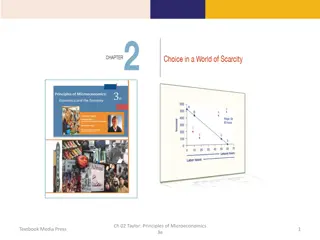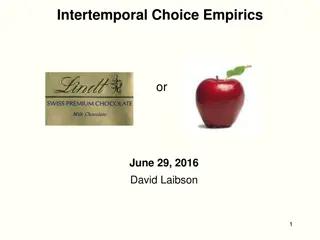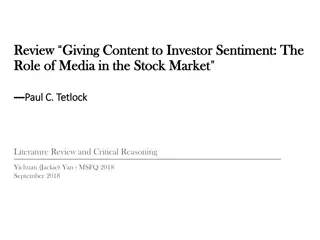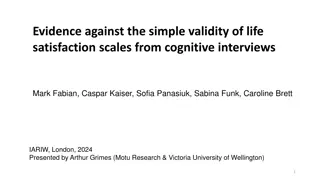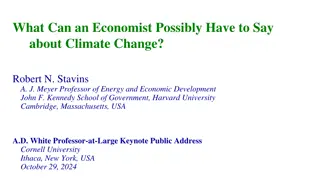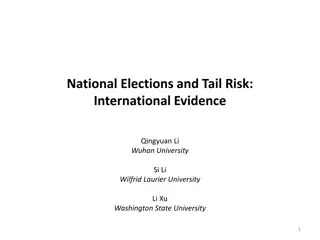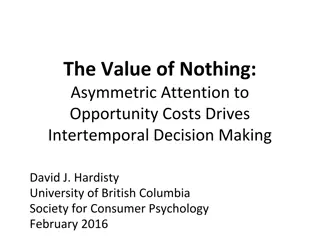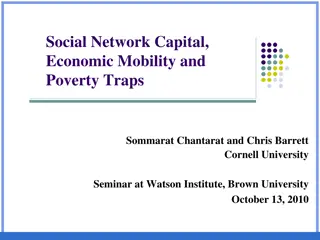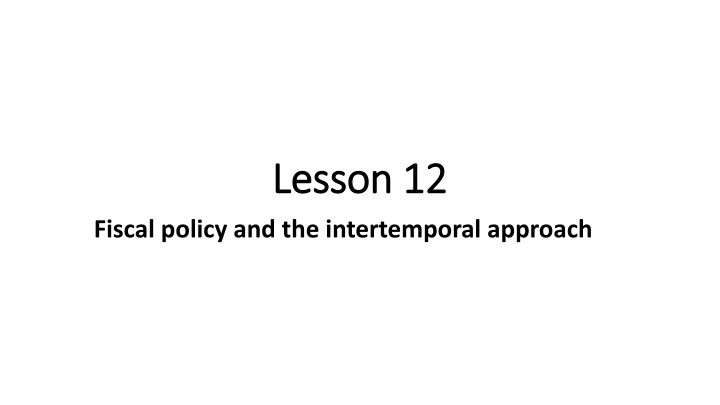
Understanding Fiscal Policy and the Intertemporal Approach
Explore the concept of fiscal policy and the intertemporal approach in economics, focusing on optimal consumption choices, Barro-Ricardo theorem, and individual intertemporal preferences. Learn how current consumption relates to individual preferences and future expectations regarding income and consumption. Discover the implications of the Barro-Ricardo theorem on fiscal policy effects and government debt repayment.
Uploaded on | 1 Views
Download Presentation

Please find below an Image/Link to download the presentation.
The content on the website is provided AS IS for your information and personal use only. It may not be sold, licensed, or shared on other websites without obtaining consent from the author. If you encounter any issues during the download, it is possible that the publisher has removed the file from their server.
You are allowed to download the files provided on this website for personal or commercial use, subject to the condition that they are used lawfully. All files are the property of their respective owners.
The content on the website is provided AS IS for your information and personal use only. It may not be sold, licensed, or shared on other websites without obtaining consent from the author.
E N D
Presentation Transcript
Lesson Lesson 12 12 Fiscal policy and the intertemporal approach
Intertemporal consumption function Consumer s utility function for the whole life U C ( ) i i = + t i U t ( ) + (1 ) = 0 Under the intertemporal constraint Y C i i = + + t i t i + + i i (1 r ) (1 r ) = = 0 0
The optimal consumption choice Lagrangian function U C ( ) Y C i i i = + + + + t i t i t i + + + i i i (1 ) (1 r ) (1 r ) = = = 0 0 0 The first order condition is: i + + r 1 1 1 1 = = u C '( ) or u C '( ) 0 + + t i + + t i i i (1 ) (1 r ) This is the marginal utility and is defined for a specific value of consumption or the optimal consumption for each period i ranging from zero to infinity.
Remarks Current consumption does not depend on current income, but rather, on the value of and r, which represent individual intertemporal preferences and the actualization rate of future expenses, respectively. The former registers individual preferences: it is affected by expectations about the future path of the economy and the attitude to choosing between the present and the future. The latter can be summarised in the average returns markets pay in exchange for higher saving today in exchange for a higher consumption tomorrow. In normal times it has as a reference value the interest rate fixed by the Central Bank. If = r, consumption remains constant through time if <r , consumption decreases and vice versa. Conditions of validity: individuals a) are not liquidity-constrained so that they can, for example, borrow resources from the future, using today the future expected income and b) can choose between present and future on the basis of the information available.
The Barro-Ricardo theorem or Ricardian equivalence theorem Using the theoretical framework defined by the intertemporal consumption function and relying on the existence of rational expectations, Barro turned Keynesian results about fiscal policy upside down: in a famous article Are Government Bonds Net Wealth? Barro (1974) demonstrated that the expansionary effects of fiscal policy are compensated by the expected tax increase and subsequent consumption reduction needed to repay the debt in the future. If this applies to expansionary fiscal policies it also applies to restrictive policies where the positive wealth effects of fiscal retrenchments compensate for the negative outcomes of fiscal policy
The theorem For individuals in two periods it is ( + ) U C = + ( ) 2 ( ) U U C 2 1 1 To be maximized under the constraint: T + C + Y + + = + + 2 C Y T 2 2 1 1 1 1 1 (1 ) r r r
The intertemporal public budget contraint G G r T + = + 2 T 2 1 + + 1 1 (1 ) r Claiming that, when considering the whole period, all public expenses have to be financed through taxes, such that at the end of its infinite life government has to match revenues and expenses. Additional hypotheses of the Barro theorem are: a) taxes at present time are zero T1=0 and b) present public expenditure is financed through the issuing of new public bonds to be sold on the private market G1=B . From these two hypotheses in the second period the following is necessarily obtained: T2=B(1+r)+G2.The consumer constraint becomes: C Y C Y r + + G + + = + + 2 B 2 2 1 1 1 1 (1 ) r r
The optimal choice in presence of the public sector ( + ) U C 1 G + Y + C + = + + + + + ( ) U C Y B C 2 2 2 2 1 ( ) r r r 1 1 1 1 1 Deriving, the first order condition is: 1 1 + + = '( ) '( ) u C u C 1 0 + + 1 2 r 1 1 From which it derives + + 1 1 = '( ) u C = '( ) u C 1 2 r
Main conclusion Consumption does not depend on current income and therefore public expenditure is not able to change individual purchase decisions in current time. Bond-financed public spending leaves household budget constraints unchanged due to the expected tax increase in the future, thus not affecting consumption today. It may be demonstrated that the same result is obtained if tax cuts are implemented and therefore it is independent of the way public expenditure is financed. As a general conclusion, an increase in public deficit, since it is accompanied by an equivalent increase in future taxes, has no effect on consumption and on the level of current equilibrium income.
Remarks The conclusions of the Ricardian equivalence theorem rely on many assumptions which limit their general validity: 1) The first is the existence of rational expectations: the individual has perfect knowledge about the future course of the economy and can predict the level of his future income. 2) The second is that public spending does not have supply side effects. In many cases, government expenditure is used to boost investments, in turn increasing firms' productivity and hence the productive capacity of the economic system. 3) The third is that the credit markets work perfectly. If, on the contrary, consumers are credit-constrained they are not able to borrow from the future to anticipate their present expenses (and vice versa), thereby limiting their ability to smooth over time their income in order to maintain their level of consumption constant. 4) The fourth is that government and households have the same time horizon at the end of which the public debt has to be repaid and the income of a whole life spent in consumption.



